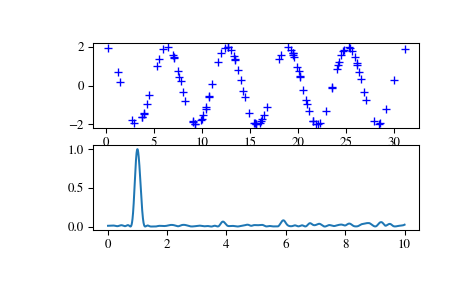scipy.signal.lombscargle¶
-
scipy.signal.lombscargle(x, y, freqs)[source]¶ Computes the Lomb-Scargle periodogram.
The Lomb-Scargle periodogram was developed by Lomb [1] and further extended by Scargle [2] to find, and test the significance of weak periodic signals with uneven temporal sampling.
When normalize is False (default) the computed periodogram is unnormalized, it takes the value
(A**2) * N/4for a harmonic signal with amplitude A for sufficiently large N.When normalize is True the computed periodogram is is normalized by the residuals of the data around a constant reference model (at zero).
Input arrays should be one-dimensional and will be cast to float64.
Parameters: - x : array_like
Sample times.
- y : array_like
Measurement values.
- freqs : array_like
Angular frequencies for output periodogram.
- precenter : bool, optional
Pre-center amplitudes by subtracting the mean.
- normalize : bool, optional
Compute normalized periodogram.
Returns: - pgram : array_like
Lomb-Scargle periodogram.
Raises: - ValueError
If the input arrays x and y do not have the same shape.
Notes
This subroutine calculates the periodogram using a slightly modified algorithm due to Townsend [3] which allows the periodogram to be calculated using only a single pass through the input arrays for each frequency.
The algorithm running time scales roughly as O(x * freqs) or O(N^2) for a large number of samples and frequencies.
References
[1] (1, 2) N.R. Lomb “Least-squares frequency analysis of unequally spaced data”, Astrophysics and Space Science, vol 39, pp. 447-462, 1976 [2] (1, 2) J.D. Scargle “Studies in astronomical time series analysis. II - Statistical aspects of spectral analysis of unevenly spaced data”, The Astrophysical Journal, vol 263, pp. 835-853, 1982 [3] (1, 2) R.H.D. Townsend, “Fast calculation of the Lomb-Scargle periodogram using graphics processing units.”, The Astrophysical Journal Supplement Series, vol 191, pp. 247-253, 2010 Examples
>>> import scipy.signal >>> import matplotlib.pyplot as plt
First define some input parameters for the signal:
>>> A = 2. >>> w = 1. >>> phi = 0.5 * np.pi >>> nin = 1000 >>> nout = 100000 >>> frac_points = 0.9 # Fraction of points to select
Randomly select a fraction of an array with timesteps:
>>> r = np.random.rand(nin) >>> x = np.linspace(0.01, 10*np.pi, nin) >>> x = x[r >= frac_points]
Plot a sine wave for the selected times:
>>> y = A * np.sin(w*x+phi)
Define the array of frequencies for which to compute the periodogram:
>>> f = np.linspace(0.01, 10, nout)
Calculate Lomb-Scargle periodogram:
>>> import scipy.signal as signal >>> pgram = signal.lombscargle(x, y, f, normalize=True)
Now make a plot of the input data:
>>> plt.subplot(2, 1, 1) >>> plt.plot(x, y, 'b+')
Then plot the normalized periodogram:
>>> plt.subplot(2, 1, 2) >>> plt.plot(f, pgram) >>> plt.show()

